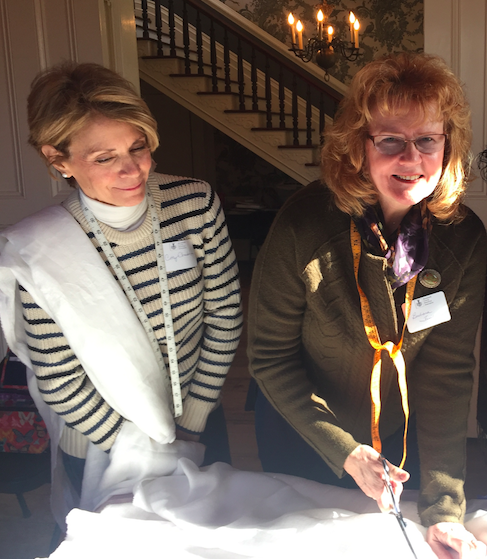By Rick Geffken |
MIDDLETOWN – Convenience trumps fashion today. A few seconds is all it takes a woman to don yoga pants and slip a tank top over a sports bra. Working at home, running errands around town or working out at the gym (the original purpose of the ensemble), this commonplace outfit is easy and comfortable.
Contrast that with the dressing ordeal a colonial housewife put herself through each morning. The 18th century woman needed a half hour to get ready for a rigorous day of farming, chopping wood, fetching water, cleaning clothes, preparing meals and dozens of other hearth and home chores. She slept in a nightgown, a plain linen shift, the basic and only undergarment of the time. On top of that she added successive layers. First, a rigid set of “stays” for back support, then two or three petticoats, a set of string pockets, several all-purpose skirts and finally a short-waisted jacket.
On Jan. 20 and 21 the Monmouth County Historical Association (MCHA) sponsored its first 18th Century Shift Workshop at the historic Taylor-Butler House on Kings Highway in Middletown. Pati Githens, outreach manager for the Freehold-based organization, taught a group of nine women how to outline, cut and sew the foundational garment every woman made by hand before sewing machines were introduced.
Unfurling a 60-inch square piece of modern linen, each woman measured, cut and stitched a custom shift. The patterns were developed from circa 1790 shifts in the MCHA’s collection.
Attendees at the weekend workshop – three from Middletown – were spared the tedious chore of converting flax into linen. The British saw to it that all the colonial wool was shipped to the mother country. As a result, handmade linen was the fabric of choice and necessity in pre-1775 America.
Linen was woven from flax, a grass-like plant grown on many Monmouth County farms. The labor intensive process involved harvesting and drying the flax, then letting it sit in streams to rot the outer coating. Once the covering was gone, the remaining long strands were pounded by a mechanical “break” to soften the fibers, then run through a series of hetchels (wooden boards with nails sticking up) to comb the flax fibers. The final step was hours-long spinning to render linen thread. The entire process from growing flax to finished cloth, including weaving and dying, took months.
According to Githens, “The stay was essential for back and bosom support. You almost looked like an ice cream cone. The bodice was cone-shaped. It wasn’t meant to be tight laced or body-modifying, like a girdle. It gave you the right posture and silhouette.” Githens says she can sit for six hours or more spinning cloth and still feel comfortable. Stays were likely the only component of women’s clothing made by men who had the required strength to insert the whalebone supports in the stay.
“If a woman was working in the home, doing laundry or cooking let’s say, she could take off her outer layers and work in just her shift and stay,” said Githens. Surprisingly, little boys wore shifts or gowns until they were three, the “potty-training years,” because it was easier for them to stand over a chamber pot. Boys also wore stays until they were around seven to help their posture. Men had it easier, wearing breeches underneath their work shirts and pants.
Cathy Chamberlain, Patricia Kennedy and Christine Parker were the Middletown participants who joined the workshop to perfect their sewing skills. Chamberlain, a Mater Dei graduate who lives in the Kings Highway area of town, signed up for the workshop after reading about it in a publication. Cathy was intrigued by a family connection. “My grandmother was a seamstress. I have a lot of her sewing mementoes and wanted to know how she started out by learning stitching from the beginning.”

The shift workshop was the latest effort to increase awareness of the MCHA’s collections at their Freehold headquarters and to help raise funds to maintain the five historic homes the group operates, including the Taylor-Butler House. “We would love to see this type of workshop continue,” said Githens. “So many people are interested in textiles, especially those involved in living-history reenactments, we are thinking of pulling other items from our collections, creating more patterns for other workshops. I can see this being the first part of a series.”
Other current workshops include hearth cooking classes offered several times a year.
The MCHA advertised the workshop on Facebook and their newly redesigned website at monmouthhistory.org. The organization was delighted by the response. The cost was $95 for members or $135 for non-members. Githens said the MCHA is always open to creating additional classes or workshops on other topics. Anyone with suggestions can contact her through the website or directly at 732-462-1466, ext. 11.
This article was first published in the Feb. 1-8, 2018 print edition of The Two River Times.
Cathy Chamberlain of Middletown (left) watches as Barbara Fischer cuts linen fabric during the 18th Century Sewing Workshop sponsored by the Monmouth County Historical Association at the Taylor-Butler House in Middletown on January 20th and 21st.














